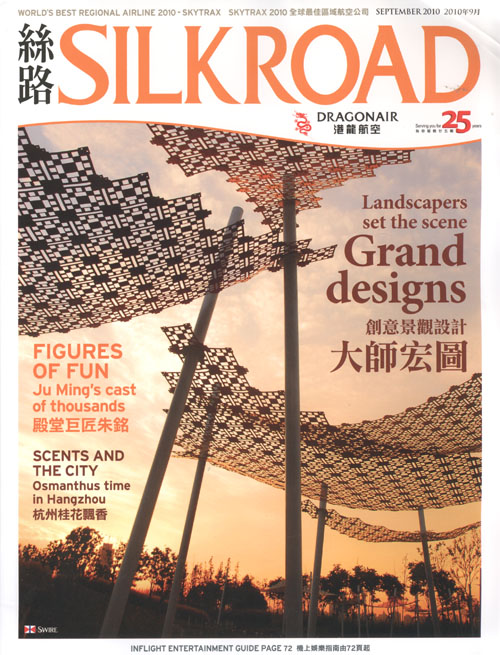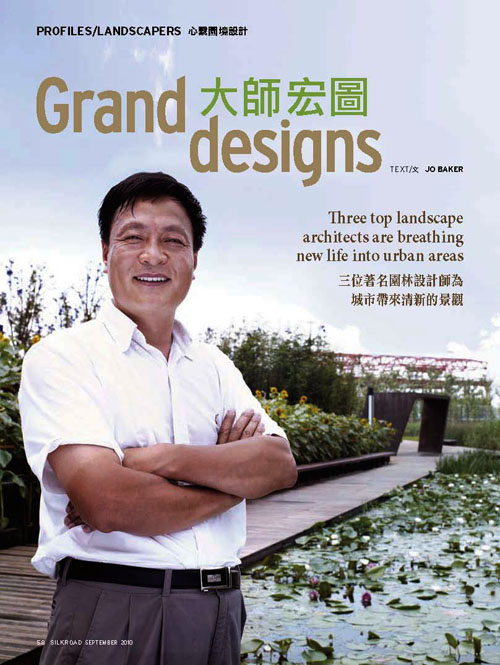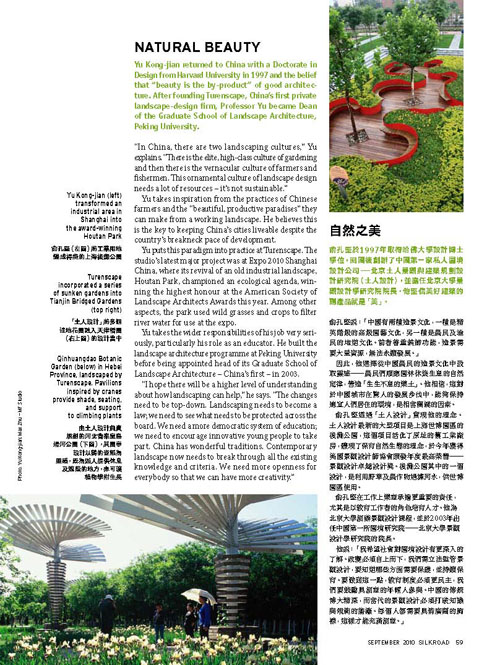大師宏圖:自然之美
俞孔堅於1997年取得哈佛大學設計博士學位,回國後創辦了中國第一家私人園境設計公司——北京土人景觀與建築規劃設計研究院(土人設計),並擔任北京大學景觀設計學研究院院長。他堅信美好建築的副產品就是「美」。
俞孔堅說:「中國有兩種造景文化,一種是精英階級的高級園藝文化,另一種是農民及漁民的地道文化。前者著重裝飾功能,造景需要大量資源,無法永續發展。」因此,他選擇從中國農民的造景文化中汲取靈感――農民們順應園林休養生息的自然定律,營造「生生不息的樂土」。他相信,這對於中國城市在驚人的發展步伐中,能夠保持適宜人們居住的環境,是相當關鍵的因素。俞孔堅透過「土人設計」實現他的理念。
土人設計最新的大型項目是上海世博園區的後灘公園,這個項目活化了原址的舊工業廠房,體現了保育自然生態的理念,於今年獲得美國景觀設計師協會頒發年度最高榮譽――景觀設計卓越設計獎。後灘公園其中的一個設計,是利用野草及農作物過濾河水,供世博園區使用。
俞孔堅在工作上樂意承擔更重要的責任,尤其是以教育工作者的角色培育人才。他為北京大學創辦景觀設計課程,並於2003年出任中國第一所園境研究院――北京大學景觀設計學研究院的院長。他說:「我希望社會對園境設計有更深入的了解。改變必須自上而下,我們需立法監管景觀設計,要知道哪些方面需要保護,並持續保育。要做到這一點,教育制度必須更民主,我們要鼓勵具創意的年輕人參與。中國的傳統博大精深,而當代的景觀設計必須打破知識與規範的藩籬。每個人都需要具備廣闊的胸襟,這樣才能充滿創意。」
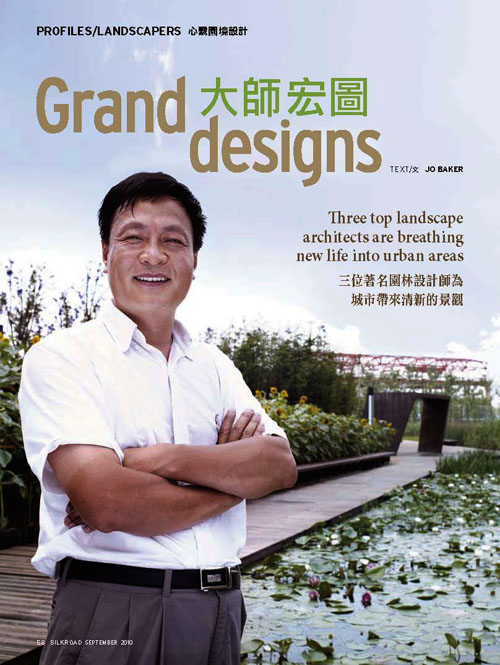
Yu Kong-jian (left) transformed an industrial area in Shanghai into the award-winning Houtan Park
俞孔堅將工業用地 變成得獎的上海後灘公園
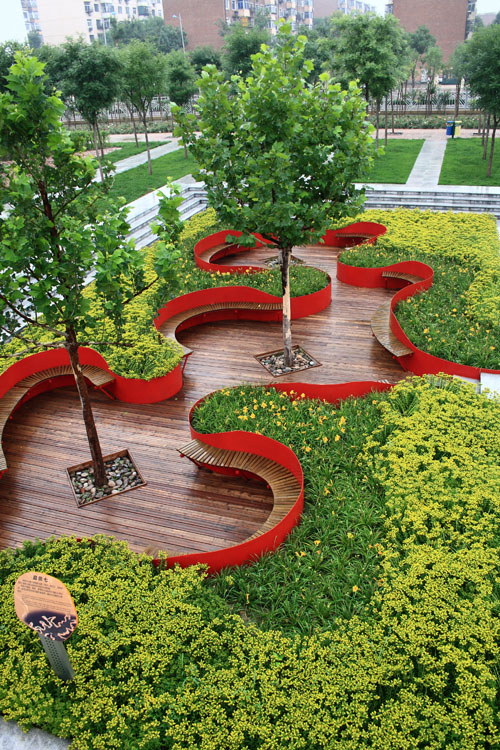
Turenscape incorporated a series of sunken gardens into Tianjin Bridged Gardens(top right)
「土人設計」將多個洼地花園融入天津橋園的設計當中
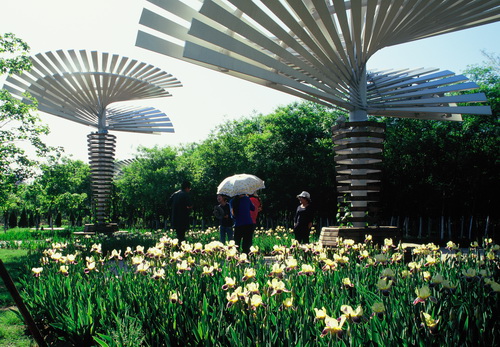
Qinhuangdao Botanic Garden in Hebei Province, landscaped by Turenscape. Pavilions inspired by cranes provide shade, seating, and support to climbing plants
由土人設計負責規劃的河北省秦皇島植物园,其園亭設計以鶴的姿態為靈感,既為遊人提供休息及遮蔭的地方,亦可讓植物攀附生長
Natural beauty
Yu Kong-jian returned to China with a Doctorate in Design from Harvard University in 1997 and the belief that “beauty is the by-product” of good architecture. After founding Turenscape, China’s first private landscape-design firm, Professor Yu became Dean of the Graduate School of Landscape Architecture, Peking University.
“In China, there are two landscaping cultures,” Yu explains. “There is the elite, high-class culture of gardening and then there is the vernacular culture of farmers and fishermen. This ornamental culture of landscape design needs a lot of resources – it’s not sustainable.”
Yu takes inspiration from the practices of Chinese farmers and the “beautiful, productive paradises” they can make from a working landscape. He believes this is the key to keeping China’s cities liveable despite the country’s breakneck pace of development. Yu puts this paradigm into practice at Turenscape. The studio’s latest major project was at Expo 2010 Shanghai China, where its revival of an old industrial landscape, Houtan Park, championed an ecological agenda, winning the highest honour at the American Society of Landscape Architects Awards this year. Among other aspects, the park used wild grasses and crops to filter river water for use at the expo.
Yu takes the wider responsibilities of his job very seriously, particularly his role as an educator. He built the landscape architecture programme at Peking University before being appointed head of its Graduate School of Landscape Architecture – China’s first – in 2003. “I hope there will be a higher level of understanding about how landscaping can help,” he says. “The changes need to be top-down. Landscaping needs to become a law; we need to see what needs to be protected across the board. We need a more democratic system of education; we need to encourage innovative young people to take part. China has wonderful traditions. Contemporary landscape now needs to break through all the existing knowledge and criteria. We need more openness for everybody so that we can have more creativity.”
